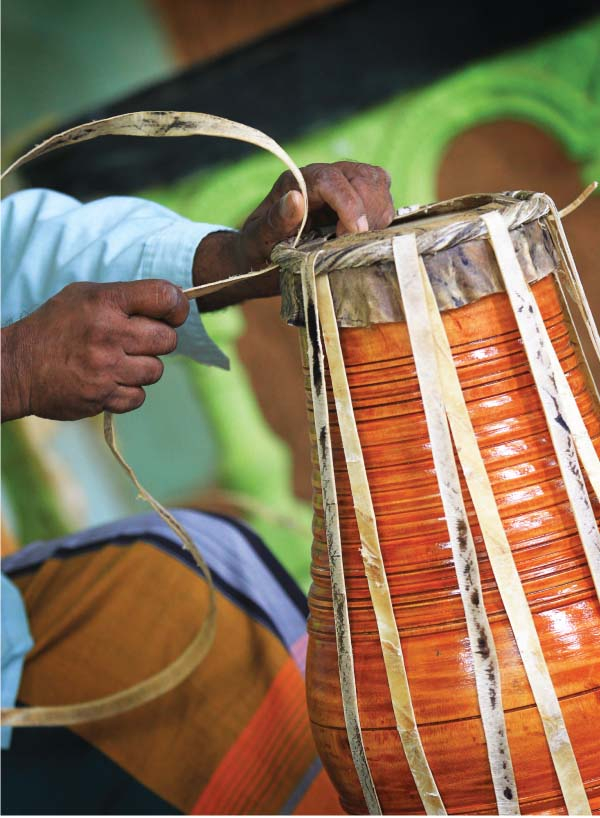
Music ran through his veins. This we were sure of as he played on the dolkiya (drum) that he and his fellow artisans had completed making. The exuding sound was a reflection of a pure bred and deeply grounded village craftsmanship and livelihood, in the little, almost hidden township within kuragala.
Words Sonali Kadurugamuwa Photographs Menaka Aravinda and Rumesh Perera
Caught Up In The Drill
Being engaged was everyone’s business. The entire little village, in fact, had a participation in this drum making soirée. The day was hot but under the shade of their makeshift working stalls, the artisans were on a roll… Hardly did we see any type of modern science or technology aiding this quiet, busy lifestyle – it was just another manic Monday for these folk and a good old social network of experienced heads and hands, from an age-old ancestral tradition, was everything that was essential in getting the job done.
Kos (Jak) wood, cut into short stumps, and axed into vague drum or bera (drums) figures was the begin-with base. Many other types of wood are also used in drum making such as ehela, kohomba (neem), coconut and milla. However, as the artisans explain, they make use of the wood most abundant in and around their vicinity.
It was just another manic monday for these folk and a good old social network of experienced heads and hands, from an age-old ancestral tradition, was everything that was essential in getting the job done.
A leewaraya or a manual pulley, with a giant wheel at one end, made the rotations along a rope cable possible, which in turn served the carver at the other end with a great productive mechanism to chisel away the spinning stump into a thammattama shape. Not much talking went alongside work mind you, which is usually quite unfamiliar in a Sri Lankan working environment, as any local would assure you, in our society; we are always up for more than a little chit chat. Nonetheless, we presumed that this silent spell may have been a vital ingredient in the intricacy and precision crucial for people in this profession.
From One Hand To The Other, Go The Bera Barrels
Drum making duties begin with the cutters and the carvers, and then it’s over to the shavers and scrapers, who sand paper the outer layer of wood to smooth out any remaining splints… the scrapers then scoop out the insides of the shaped wood to form hollow cavities and leave the unfinished bera out to dry. Meanwhile up the village trail, the polishers apply a varnish to protect the dry wood and also to bring out its natural colour. Goat and cattle hide lay stretched, drying in the sun and once completely parched, they are meticulously cut into circles to form coverings for the hollows in the bera and then stripped as binders to hold the lids in place, while more dried skins are slit laterally as streamers that will run the length of taller drums. Thereafter, the grinder, with a mortar pestle grinds up a black porous rock, and pastes the granules to make up the small centre circle on the flat hide coverings or faces, on either side of the bera.
Did You Know?
Each side of the same drum coverings can be made with different animal hides to diversify the resonating sound or beat.
Some animal hides come from the monkey and even the monitor lizard.
The karakawana rabana also known as the spinning rabana are a variety of drum that Perahara entertainers spin on swords.
Ornamented clay pots or traditional water carrying jugs are used for drums, during the time of paddy harvesting in villages.
Going Deeper Into Tradition…
Even the generations before, the artisans’ great grandfathers were drum-makers and it was plain to see down to this day, where all the hardwork had penetrated into. The final skill was presented to us by craftsmen who consulted the finishing touches to the bera by drumming them to elucidate their power and diversity of sound. Each drum spoke a different beat and each beat was for a different cause, for weddings and festive celebrations alike, for ritualistic dances, some for holy ceremonies, performing instrumental music and of course, my personal favourites… as party starters. Even historical chronicles, like the Mahavamsa accounts the use of drums in numerous occasions dating as far back as 2,500 years. All in all they were and still are a custom of melodious communication embedded in cultural roots.
In vibrant yet neutral colours, the many drums dressed in the skilful efforts of their creators, await their long journey to upmarket shops, mainly in the commercial capital of Colombo, where their worth pays off. Uda Rata (up country) bera, Pahatha Rata (southern coastal regions) bera, Yak bera, Geta bera or Dandu bera, the drum line is simple… step to the beat! With nearly 40 varieties of bera, most of which were being made in this village and other similar communities, the beat truly does flow through the veins of the island paradise.
[nggallery id=364]


